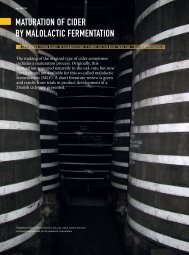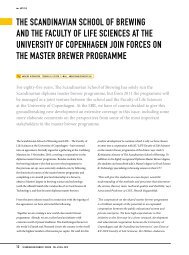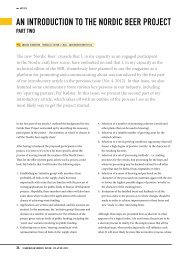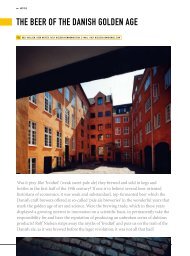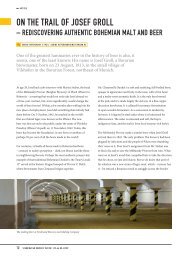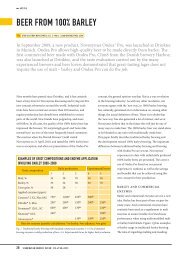the Supply chain ManageMent proceSS - Scandbrewrev.dk
the Supply chain ManageMent proceSS - Scandbrewrev.dk
the Supply chain ManageMent proceSS - Scandbrewrev.dk
Create successful ePaper yourself
Turn your PDF publications into a flip-book with our unique Google optimized e-Paper software.
The <strong>Supply</strong> Chain Management Process<br />
We see <strong>the</strong> supply <strong>chain</strong> not as a series of separate operations<br />
and organisations but as a complete end-to-end process of<br />
harvesting, manufacturing, warehousing, transporting, delivering<br />
and ultimate consumption.<br />
large or small. <strong>Supply</strong> Chain Management is not just for large<br />
organisations such as IBM, Wal-Mart, and Toyota.<br />
In a typical supply <strong>chain</strong>, raw materials are procured and items<br />
are produced at one or more factories, shipped to warehouses<br />
for intermediate storage and <strong>the</strong>n shipped to retailers or<br />
customers. Each member of a supply <strong>chain</strong> will have a different<br />
understanding of what a supply <strong>chain</strong> is reflecting in <strong>the</strong> nature<br />
of <strong>the</strong>ir business and <strong>the</strong> inputs and outputs produced. For<br />
some, supply <strong>chain</strong> is related to purchasing and procurement, to<br />
o<strong>the</strong>rs it is warehousing, distribution and transportation. Yet for<br />
o<strong>the</strong>rs, <strong>the</strong> emphasis will be on sources of capital and labour.<br />
Our definition includes all value-added activities required<br />
to plan, source, make and deliver products and services that<br />
ultimately meet customer needs. This includes <strong>the</strong> flow and<br />
exchange of information and <strong>the</strong> flow of money. <strong>Supply</strong> Chain<br />
Management is a process aimed to optimise integration of<br />
suppliers, manufacturers, warehouses and distribution, so that<br />
product is manufactured and delivers at <strong>the</strong> right quantities, to<br />
<strong>the</strong> right locations, and at <strong>the</strong> right time, to reduce costs over<br />
<strong>the</strong> whole <strong>chain</strong> to satisfy customer requirements. The objective<br />
is to optimise <strong>the</strong> <strong>chain</strong> as a whole and not just one component<br />
of <strong>the</strong> <strong>chain</strong> and it is more than just <strong>the</strong> flow of materials.<br />
<strong>Supply</strong> Chain Management considers demand, supply and<br />
inventory needs for each item of production and in particular<br />
looks at how inventory flows through <strong>the</strong> system to achieve<br />
output to <strong>the</strong> customer’s specification, in <strong>the</strong> right quantities,<br />
on time and at least cost to <strong>the</strong> <strong>chain</strong> as a whole. With <strong>Supply</strong><br />
Chain Management, customer service is increased through <strong>the</strong><br />
reduction of lead times and <strong>the</strong> product is always exactly as<br />
specified and it is always delivered on time. This is <strong>the</strong> delivery<br />
of a ‘perfect order’. Costs are reduced through <strong>the</strong> elimination<br />
of any activity that doesn’t add value and through <strong>the</strong> reduction<br />
of inventories of material and associated holding and handling<br />
costs throughout <strong>the</strong> <strong>chain</strong>.<br />
We see <strong>the</strong> supply <strong>chain</strong> not as a series of separate operations and<br />
organisations but as a complete end-to-end process of harvesting,<br />
manufacturing, warehousing, transporting, delivering and<br />
ultimate consumption. A simplified supply <strong>chain</strong> taken from an<br />
American textbook is illustrated on <strong>the</strong> left-hand page.<br />
Illustration 1 shows <strong>the</strong> up-stream flow of information, cash,<br />
and data and <strong>the</strong> downstream flow of credit, ideas and design,<br />
and <strong>the</strong> flow of materials to <strong>the</strong> end customer.<br />
Activities and measures based on customer requirements<br />
are very important in improving business performance. But<br />
Table 1:<br />
Performance R e s o u r c e e f f i c i e n c y ( V O B ) V o i c e o f C u s t o m e r ( V O C )<br />
Gap Matrix<br />
Machines<br />
1st<br />
Suppliers<br />
2nd<br />
Labour<br />
3rd<br />
Specification<br />
1st<br />
Price<br />
3rd<br />
Time<br />
2nd<br />
P E R F O R M A N C E OK 70% 80% 80% OK 60%<br />
SCANDINAVIAN BREWERS’ REVIEW . VOL.67 NO.3 2010 13



